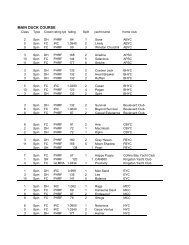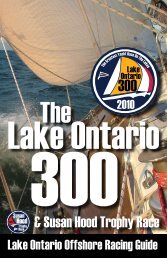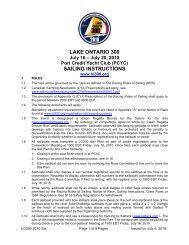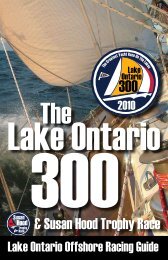Create successful ePaper yourself
Turn your PDF publications into a flip-book with our unique Google optimized e-Paper software.
Page 96 <strong>Lake</strong> <strong>Ontario</strong> <strong>Offshore</strong> Racing Guide <strong>Lake</strong> <strong>Ontario</strong> <strong>Offshore</strong> Racing Guide Page 97<br />
11.4 Blankets, warm clothes, sleeping bag. It is recommended that flotation<br />
suits be carried.<br />
11.5 Approved firefighting equipment.<br />
11.6 A small bag rigged to float (i.e. attached to a fender) containing equipment<br />
for use in the event of abandoning ship (dye markers, flares,<br />
waterproof VHF, mirror, knife, etc.).<br />
The contents of this equipment list are minimum requirements. It is recommended<br />
that all participants are familiar with ISAF <strong>Offshore</strong> Special Regulations,<br />
Category 3 Monohulls which can be found at www.sailing.org/documents/special-regs.php<br />
web site.<br />
Please remember to check the www.loshrs.com web site for final versions of<br />
the Notice of Race, Sailing Instructions and Equipment Requirements.<br />
Don’t forget<br />
the LOSHRS<br />
Banquet.<br />
Enjoy great food and time with<br />
friends. Pick up your flags<br />
and trophies.<br />
Nov. 5th,<br />
2011<br />
Reading<br />
The Wind<br />
by Dick Steigenga<br />
It was time, MacIntosh’s instruments needed to be replaced after 25 years.<br />
Every season saw the loss of another function so that the last year we<br />
sailed with a GPS unit duct taped into an opening port facing the helm.<br />
The old system a, Dana Navigate, had served us well, and a collection of spare<br />
parts donated by other sailors kept it going well beyond the original “best<br />
before date”. In the early 90s we had learned how to tap into the NMEA 0183<br />
data bus and input all the data into a computer. Laptop computers were just<br />
coming on the market and they were terrible in bright light, never mind direct<br />
sunlight. MacIntosh sailed with an IBM 286 with the hard drive removed<br />
strapped into a locker and an amber monochrome monitor bolted onto a shelf<br />
viewable from the helm.<br />
Why? Well, I had attended a course run by a major instrument company that<br />
extolled the virtues of target speeds. By this time we had an IMS certificate,<br />
(which was supposed to solve all rating issues forever and bring about peace<br />
and goodwill to the racing community) and the premise was that if we were<br />
able to sail to our targets, and maybe hit a few shifts, we would win. The problem<br />
was, were we up to speed? And,.... on the beats and runs, were we sailing<br />
too fast or too slow to make the best VMG? The answer was the computer.<br />
The computer read the inputs of boat speed, wind speed and wind angle and<br />
calculated the target speed for the conditions based on an expanded IMS database.<br />
It was like having a coach onboard giving us instant and constant feedback<br />
on how we were doing, but with an off switch. Did it help? Yes it did, but<br />
I think the biggest contribution was that it helped to learn how to get the best<br />
out of the boat. With time, we could tell if we were in the groove.<br />
So now it was time to replace the instruments and I wondered if I could find<br />
a system that provided the same functionality. A search on the internet led me<br />
to Grahame Shannon who was developing software under the brand name of<br />
AVIA. Advanced Virtual Instrument Applications.<br />
The attraction of his system was that the entire instrument array could be on a<br />
computer screen in any combination of digital or analog instruments but the<br />
real attraction was that it has real-time polar charts with a simple indication of<br />
how well you are sailing; Efficiency. Whenever the boat is on the target speed,<br />
you’re at 100% efficiency.<br />
Now, there’s nothing wrong with sailing faster than 100%, except on down-










